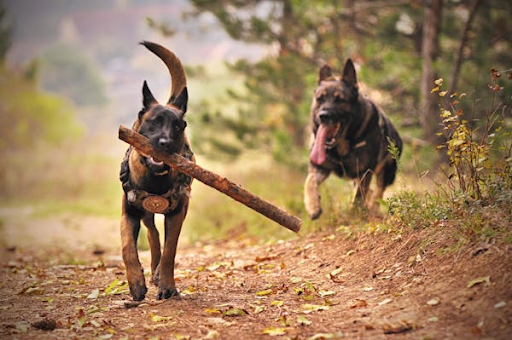Dogs struggle with reactivity; if they don’t have help, they may become aggressive.
Your dog starts barking frantically at a glimpse of another canine or a human, so you have to haul them away from your peaceful stroll.
This dog is reactive; that is, it overreacts to everyday events that other dogs might find acceptable. Although reactive dogs may not always become violent, it is crucial to pay close attention to training since reactivity can develop into hostility.
Common triggers unnecessarily agitate reactive dogs. They could snarl, lunge, or bark because they are so focused on whatever is making them feel that way that they might be hard to manage and get away from.
Reactive dogs are typically timid canines. Genetic factors may play a role, but lack of socialization, negative events in the past, or inadequate training are more likely causes.
Similar symptoms are seen by aggressive dogs, but their goal is to hurt and destroy. Reactive dogs should be treated carefully since they can be provoked into being aggressive.
Steer clear of agitated dogs
In an ideal world, reactive dogs would never be desired. Although mature dogs can be assessed or taken for a “test run” on a walk, it might be more difficult to forecast an adult puppy’s behavior.
If at all possible, try to get to know the parents of the litter you’re interested in adopting as reactivity and personality traits are typically inherited by puppies. If it isn’t feasible, at least, before weaning, consult Sit Means Sit and then visit the litter.
Although they are there to defend their puppies, mother dogs shouldn’t be violent. Instead of shrinking or hiding, puppies should be gregarious, self-assured, and gregarious, approaching you for attention.
Finding the triggers
Finding the precise triggers that irritate your canine should be your first step. Anything that stimulates your dog to respond violently is a trigger. This might be other dogs, an odd human, or both. Typical scenarios include males with beards, kids, other dogs, and people with quirky hats.
While some dogs may only react in specific circumstances, others may react to these cues in every environment. When other dogs are around them off leash, some dogs get along quite great, but the fact that they are leashed is known as leash reactivity.
Reactive behavior in other dogs may be more common in crowded or cramped areas and during nighttime walks.
Try to stay away from triggers once you’ve identified them as you develop a training schedule. The act should not turn into a deeply formed habit. Don’t take your canine to the dog park and walk them when other people aren’t there.
Keep your dog safe
Putting your canine in uncomfortable settings will only make them more fearful and may even worsen their behavior. Exercise caution while you and your dog are out. Try to stay away from anyone or any dog that seems like they could agitate your dog.
Give your dog an opportunity to take them for walks and quiet excursions so you can tell them how terrific a dog they are and they will begin to unwind.
Keep in mind that not every person or dog has to be buddies with your dog. The belief that every dog ought to adore every other dog and every other person is primarily an American concept.
Dogs are everywhere in Italy, yet humans don’t often approach them to pet them, and they keep them apart from other dogs. In this way, they respect a dog’s personal space and treat their pets more like humans.
You must speak out for your dog. To prevent them from feeling the need to defend themselves, shield them, for instance, from a stranger towering over them.
Should someone keep coming up to pet your dog or trying to pet them, politely but firmly explain that the dog is a working dog, shy, or in training. Click here to read more about dogs known as working dogs. Most people will typically learn from this that it is important to respect your personal space.
Reversing the conditioning
Avoidance isn’t a permanent answer, of course. The long-term solution is behavior modification and counter-conditioning, which will provide your dog with coping mechanisms to handle stressful circumstances and help make his triggers less frightening.
Begin by carrying snacks with you at all times. Right away as the trigger manifests, give the dog a reward. Treat them as you walk by or as the terrifying object goes by.
When first giving the incentive, try to keep your dog as far away from the trigger as possible and feel cozy. For example, you might have to maintain a whole soccer stadium between yourself and some children who are playing.
Your dog will learn to link the trigger with good things with regular and consistent training. Hopefully, at some point, they’ll notice another dog and come to you for a reward. Positive reinforcement (https://dictionary.apa.org/positive-reinforcement) can also be achieved via toys and compliments.
You will eventually be able to approach the frightening stimuli more closely. Make sure you maintain control of the issue by enlisting the assistance of a buddy. In order to help your dog focus and stay calm, you may, for instance, invite a friend who has a calm dog to stroll across the street opposite where both of you and the dog are working.
Give your dog something to chew on. If your dog is still quiet and attentive to you, invite your friend to take a few steps closer.
Ask your companion to go away if your canine begins to show signs of stress. You may also do this with kids or individuals wearing hats, for instance.
Establish a strategy to work alongside your dog consistently and help them link triggers with a pleasant treat (or toys or praise) in order to help make them less frightening. If you’re having trouble, see a fear-free animal trainer or veterinary behaviorist to develop a plan specifically for your canine.
Keep an eye for more latest news & updates on Newsbreak Blog!

